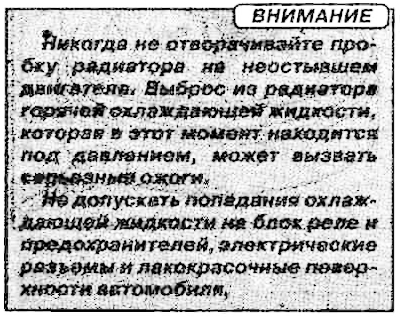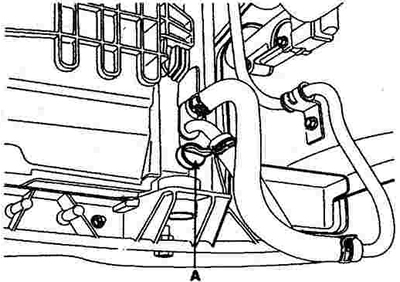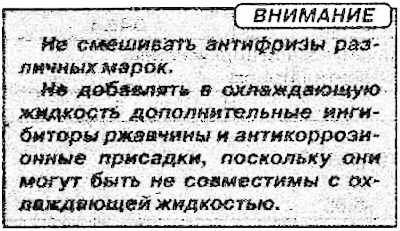
1. Set the heater temperature adjustment lever to the highest possible temperature. Make sure the engine and radiator are cool by touching.
2. Remove the radiator cap.
3. Unscrew the drain plug (A) and drain the coolant from the system.

4. Securely tighten the drain plug of the cooling system (A).
5. Remove the expansion tank of the cooling system. Drain the coolant from it and reinstall the reservoir.
6. Fill the tank up to half with water, and then top up with antifreeze. The proportion of the mixture of antifreeze with water is approximately 4:6.
7. Using caution, pour coolant through the radiator cap. Move the upper and lower radiator hoses to make it easier to remove air pockets from them.
Note:
- Use only ethylene glycol based coolants.
- For optimal protection against corrosion processes, the concentration of antifreeze in the coolant should be at least 50% throughout the year. A lower concentration of antifreeze is not able to provide protection against corrosion and freezing of the coolant in winter.
- Antifreeze concentrations above 60% are also not recommended due to reduced cooling efficiency.

8. Start the engine and let it run for a while to allow the coolant to circulate through the system. When the electric fan of the cooling system starts to work, add coolant through the radiator cap.
9. Repeat step 8 3-5 times to completely remove air from the cooling system.
10. Stop the engine and let it cool down. Screw on the radiator cap and pour coolant into the expansion tank up to the mark «MAX».
11. Start the engine at idle. After two or three turns on of the electric fan, stop the engine and let it cool down.
12. Repeat steps 6 - 11 until the level in the expansion tank stops decreasing to completely remove air from the cooling system.
Note. Since it is necessary for the engine to cool completely to completely remove air from the cooling system, check the fluid level in the expansion tank again after 2-3 days.
